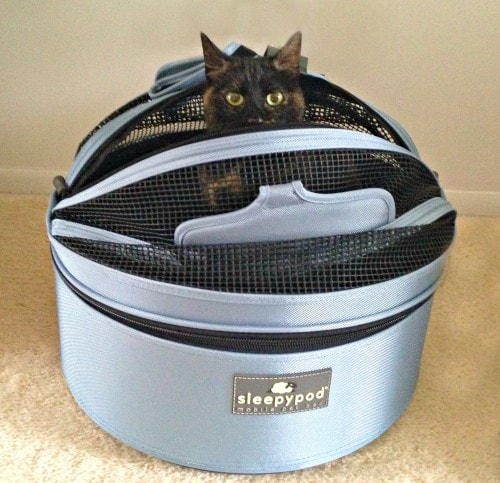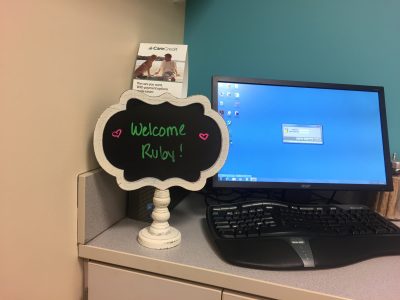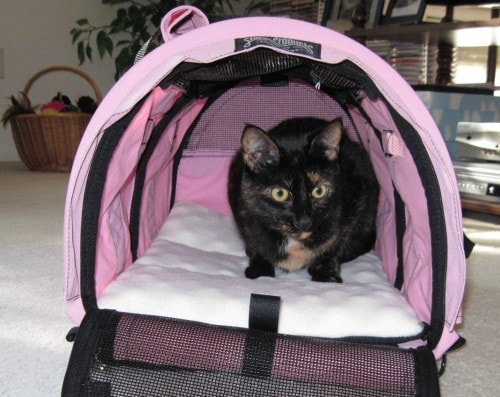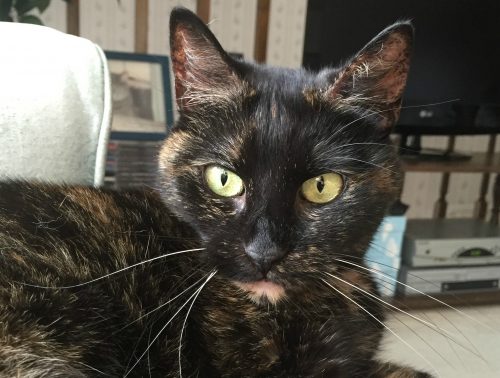
This is the third installment of our four-part series “Ruby Goes to the Dentist,” in which I share my recent experience with Ruby. I’m hoping that it will not only put your mind at ease if you’re faced with a cat who has to have a dental procedure, but that it will also help you ensure that your cat gets the optimal level of care before, during and after her dental work.
If you’ve missed the first part in this series, please read Ruby Goes to the Dentist – Part One: Diagnosis, and Choosing a Veterinary Dentist
If you’ve missed the second part in this series, please read Ruby Goes to the Dentist – Part Two: Preparation
Leaving for the dental clinic
The dreaded day had arrived. I will admit that no matter how much I tried to not feel anxious the day and night before, none of my tried and true techniques for reducing anxiety – meditation, deep breathing, herbal remedies, flower essences – quite did the trick. I did my best to stay as calm as I could.
Ruby was not thrilled that she didn’t get breakfast, but after some fussing, both girls settled into their normal morning routine of napping while I worked for an hour or two, then had breakfast.
Finally, it was time. I needed to put Ruby in the carrier. I briefly closed Allegra into my bedroom. I did not want her to see me put Ruby in the carrier. I was also worried that Ruby might be rather vocal about her displeasure, and I did not want to risk stressing Allegra out wondering what was going on. Thankfully, my “surprise” plan worked: I was able to put Ruby in the carrier without any fuss. However, once she realized that she was trapped, she was not happy. I had never heard sounds like that come out of my little girl!
I put the carrier in the car, and quickly went back into the house to open my bedroom door. Allegra gave me a curious look, but had already started to settle on my bed for her morning nap.
It’s a 25 minute drive from our house to the dental clinic, and for the first half of it, Ruby cried and cried. I played Through a Cat’s Ear: Music for Calming for her in the car. These recordings, re-orchestrated especially for animals to provide comfort and reduce anxiety, feature soft piano and string versions of classical pieces. The music helped relax me a little, and eventually, Ruby calmed down, too.

Exam with Dr. Chamberlain
Once we got to the clinic, the receptionist ushered us directly into an exam room, so Ruby wouldn’t be exposed to other animals in the waiting room. I opened the carrier while we were waiting for Dr. Chamberlain. Ruby cautiously peeked out, then climbed on my lap. A few minutes later, Dr. Chamberlain entered the room. Ruby practically flew back into her carrier! I gently lifted her out again, and Dr. Chamberlain examined her mouth, and listened to her heart. He advised me that just on visual exam, he could see several teeth that most likely would need to be extracted. I had expected some extractions, so this did not come as a surprise. Of course, the full extent of what would need to be done wouldn’t be apparent until Ruby was under anesthesia and x-rays of her mouth had been taken.
Waiting and worrying
Ruby would be the second procedure of the day. Thankfully, the clinic had an empty room available where I could sit with her until it was time to induce anesthesia. Ruby sat quietly in her carrier, but I could tell how stressed she was. Every time there was a noise outside the door, she tensed up.
In the past, I was always able to observe my cats during dental procedures, since they were either done at a clinic I worked at, or by a veterinarian who was a friend. While I could have asked, and probably would have been approved, to watch Ruby’s surgery, as with Allegra’s procedure, something told me that it would better for all of us if I was just going to be the worried mom in the waiting room.
After a couple of hours, it was time. Jenn, Dr. Chamberlain’s technician, came out into the waiting room with an update. The x-rays showed that Ruby had multiple resorptive lesions. There was also a lot of damage to other teeth below the gum line, something that hadn’t been evident on a visual exam. Dr. Chamberlain recommended extracting all of Ruby’s teeth.
I had expected multiple extractions, but this came as a shock. Since I completely trust Dr. Chamberlain’s recommendations, I agreed, but it took me a while to wrap my mind around this. Buckley had had all her teeth extracted to treat her severe stomatitis, so I had experience with this. I knew that cats do just fine without teeth, but the thought of your cat having to go through this is pretty brutal even when you know what to expect.
Visual dental exams are not enough to assess dental problems
Unfortunately, this also perfectly illustrates why visual dental exams are not always good enough. Sometimes, as was the case with Ruby, the real damage occurs underneath the gum line. For this reason, I can’t stress enough just how important it is that the practice you choose to have your cat’s dental work done at not only has dental x-ray capabilities, but that the veterinarians also have extensive experience interpreting dental x-rays.
Jenn advised me that it would be at least four or five hours before Ruby could go home. I was worried about Allegra being at home by herself for that long, so rather than sitting in the waiting room at the clinic, I went home.
I shouldn’t have worried. Allegra apparently couldn’t have cared less that her sister wasn’t there! She was totally relaxed and followed her usual routines.
Ruby was under anesthesia for three hours. About an hour after they finished, Lauren, another of Dr. Chamberlain’s technicians, gave me discharge instructions for Ruby. Then she brought a groggy looking Ruby back to me. It was finally time to take my baby home.





Get well soon, Ruby! And thanks, Ingrid, for sharing once again. Your Conscious Cat is such a benefit to us all.
Thanks, Marie!
It is always scary when someone we love has to go under ( 2-legged or 4-legged). The tooth fairy needs to visit Ruby.
Ruby will have quite the stash if the tooth fairy comes to visit, Ellen! 🙂
So glad Ruby is okay. I have waited for a cat having surgery so I know what you went through.
She’s lucky you have had experience dealing with a cat having to extract all it’s teeth. Sending positive thoughts your way!
Thank you, Georgia!
I’m so sorry for all the stress and hope your baby recovers swiftly. What kind of carrier is she in in the photo? Would it fit under an airplane seat?
That’s a Sleepypod Mobile Pet Bed, Vicky. It won’t fit under an airline seat, but Sleepypod makes the Sleepypod Air, which will fit.
This is so very helpful as I am going to have to have extractions done soon on my cat. I worry about safety and this series is very educating. I moved to Leesburg, VA 2 yrs ago so it is great that you are in my area. I have been following your blog for years from Chicago. Imagine my pleasant surprise to find you live near where I do now.
Not only do I live near you, but Dr. Chamberlain is in Leesburg, Pam! Your kitty will be in good hands.
Oh no! How distressing for both of you. I’m sending positive energy for soothing and healing.
Thank you, Lisa!
Aww poor baby. Sorry she lost all here teeth.
Thank you, Ingrid, for sharing every step of this journey with us! I’m glad it’s over (well, the worst part is) and Ruby is OK. One vet I know always says they are better off with no teeth at all rather than with bad teeth. I know how stressful it has been for both of you, that’s how I feel right now. We are taking one of our girls on Monday for her dental. I can tell she definitely needs cleaning and most likely some extractions, the x-ray will show how bad it is. Ideally I wanted to take her to cats only vet clinic, but those I trust don’t have a dental x-ray, so we’re taking her to our regular vet, which is a mixed practice. We trust our vet, but I’ve learned one thing so far: quite often if a clinic or shelter has/serves both cats and dogs, cats are often overlooked and aren’t taken as good care of as dogs are, they are definitely on the back burner. So, I’ve been reading up on pain management protocols, anesthesia and so on for cats, to see what is best and which drugs are the safest, so I can discuss it with our vet before the procedure. I understand that each cat will be given medications depending on his/her age and health issues if there are any. Do you mind sharing what Ruby’s anesthesia and pain management protocol was? What did the doctor use for sedative, induction, nerve blocks and then post-operative medications? Since she has a full mouth extraction, she’s probably on opioids. I want to avoid NSAIDs and wonder, if we have at least a few extractions a small dose of opiod is a safer route to go (as far as we know, our girl, who will be 4 y.o. this year, doesn’t have any health issues, of course we’ll know for sure after the blood test which they do before the procedure). For premeds I really don’t care about ketamine due to it causing muscle rigidity and the burning sensation upon the injection, but I read that muscle rigidity is reduced if ketamine is mixed with midazolam. Is it really Ok to use propofol, since it’s supposed to have minimal risks, or should we ask our doctor if there are other options that have even fewer risks or side effects? All those questions are driving me crazy and I hope I’m not going to offend our vet when discussing them with him. One of your articles on what we should ask our veterinarian before a dental procedure has been very helpful to me and put me on this track which led to more research. Any input or advice from you will be greatly appreciated. Thank you! Me and my gang wish Ruby a speedy recovery.
I’m actually not sure what Dr. Chamberlain’s exact anesthesia protocol is, Olya. Since my own vet completely trust what he uses, I didn’t ask specific questions. Ruby got an injection of Metacam (which is an NSAID) after the surgery, and was sent home with five days worth of Buprenex (an opioid) three times a day. She also got an antibiotic injection (cefazolin) during the surgery, and a five day course of antibiotics (Clavamox.) You absolutely should discuss your concerns with your vet. All my best to your kitty, and thank you for the good wishes for Ruby!
Thank you, Ingrid!
I feel for you with all my heart! All my energy for a quick and seamless recovery. If it’s any comfort, I would be even more anxious than you,
Thank you, Barbara!
My beautiful Sophie, also a tortie, had this same surgery last October, only a month after she came to live with me. The diagnosis was stomatitis. Soph has 11 teeth remaining, which I brush every morning. She recovered beautifully from the surgery and is a happy, healthy girl. I know this is as hard on us as it is on our kitties. Sending love.
Thank you, Linda! Buckley had stomatitis, so I’m very familiar with how challenging that can be.